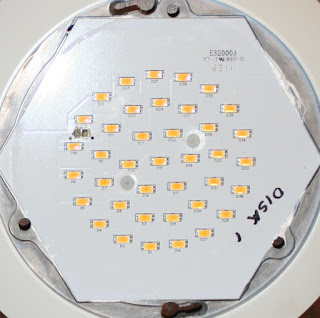6A is on the left. 6B, the only revision I am aware of, is on the right.

In the 6A failures, both were in the rather flimsy wiring. In one, the ultimate DC connector at the metal back, came off in the necessary step of squeezing and uncoupling the little black quick connector. Resetting the connector receptacle half with epoxy didn't restore electrical contact. In the other, the plate and its connector are good, but something is wrong in the two-block power converter. I can't ignite the light by wiggling wires, but surely the lost connection is in the wires, not inside the blocks.
I have at last drilled out the three posts securing the lens to the plate, of the light with the failed connector. The posts are held by Starlock fasteners, removable only by destruction.
There is an array of twenty nine little LEDs, and surprising hand marking. This light was manufactured in June, 2011, early in production, where first sales were in September, 2011.
A wet white grease thermally couples the diode plate to the metal body of the light.
I won't throw this away. I have offered it to a friend, who will solder on new leads, and run it in a 24 vdc circuit. There is so much good workmanship to be honored. This is so much more repairable than an iPod.
Here is the back-side view of a 6B Glimpse light:
I won't ruin a good light by detaching the lens. Yet, I am able to make some comparisons to 6A.
The LED array is quite different, probably brighter and fewer diodes. All LEDs fit on a circle the diameter of the power block. Note four oval half-inch holes, where you can reach through and touch the inside of the lens. In some installations these holes might admit bugs. In a perforated can light or poor junction box, light may show in an attic floor or dark ceiling cavity, a magnet to bugs. Holes for ventilation? I don't think so.
At 4/30/2013, edit for the text now maroon. Some LED lights do not attract bugs. I can't remember a bug ever flying at these lights. I must do and report on, some careful observation.
I wish LSGC would promote public excitement about these lights. A sleepy marketing process through commercial distributors has failed them. Buyers will not accept multiple markups of thirty percent, in any consumer product. We need these lights, at lowest-possible cost, in very large quantities. In deserved frequent design upgrades, let there be trial of full-spectrum lighting, with a distribution of phosphor colors. (Is it simply variation in phosphor thickness?) Where a light will long outlive a cat, it should be of correct color. Wiring now as DC must be no big deal, allowing full control of humming complaints where dimmed.


2 comments:
nice to see this thanks for the share of LED Lights
Energy Saving is one of the big questions for todays world. By LED Lights you can save mpre energy other then other lights.
Post a Comment